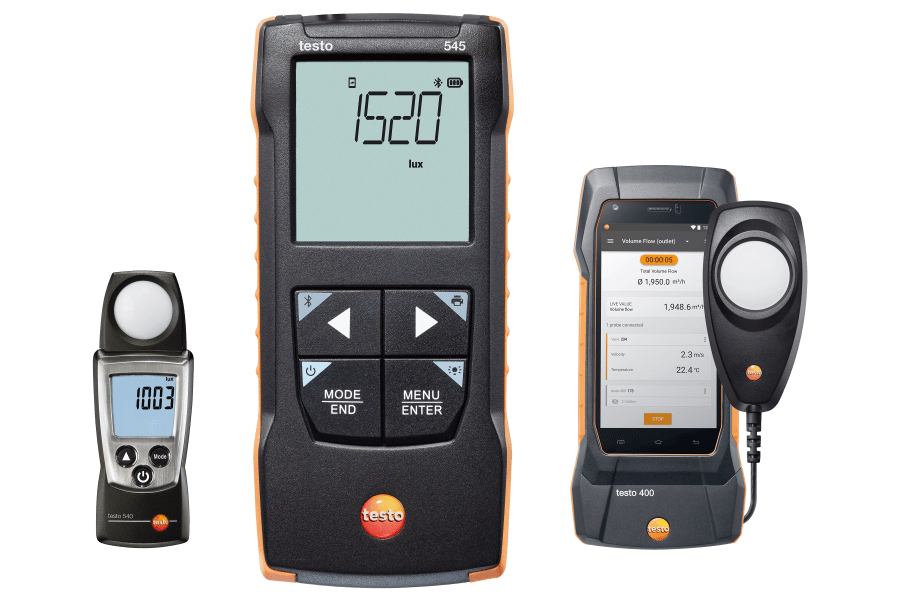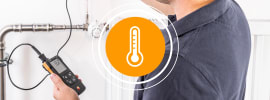조도계
조도 및 배광은 성능 및 작업 안전과 같은 요소에 중요한 영향을 미칩니다.

빠르고, 안정적이며, 매우 정밀한
테스토 조도계를 사용하면 최적의 실내 조도 상태를 보장할 수 있습니다. 테스토 조도계를 이용한 일상적인 조도 측정의 일반적인 적용 분야는 다음과 같습니다:
작업장 및 공공 건물의 조명.
전시회 및 박물관의 배광.
생산 라인의 기계 조명.
조도계로 럭스를 측정하는 방법 - 어떻게 작동하나요?
광원과 광원이 비추는 면적 사이의 광력(단위: 루멘)은 럭스(lx) 단위를 사용하여 측정합니다. 1루멘(lm)의 광력이 1제곱미터의 면적을 균일하게 비출 때 조도는 정확히 1룩스입니다. 럭스 측정기는 럭스 미터 또는 광도계라고도 합니다.
이상적인 조도계 - 엔트리 레벨부터 전문가용 모델까지
다음에도 관심이 있을 수 있습니다.
테스토 조도계의 장점
시장을 선도하는 테스토는 조도 측정을 위한 고정밀, 검증된 조도계를 제공합니다.
컴팩트한 디자인: 편리한 조도계는 특히 빠르고 간편하게 측정하는 데 적합합니다.
센서는 사람의 눈의 스펙트럼 감도와 일치합니다.
홀드 기능으로 편리한 측정값 판독.
몇 초 만에 측정: 사무실이나 소매점에서의 현장 측정에 이상적입니다.
크고 선명한 디스플레이. 또한 버튼 하나만 누르면 최대값과 최소값을 쉽게 표시할 수 있습니다.

작업장 내 조도 측정: 테스토의 정밀한 센서로 측정
눈은 인간의 가장 중요한 감각 기관 중 하나입니다. 우리는 80% 이상의 정보를 눈을 통해 받아들입니다. 따라서 환경이 어두울수록 정보를 받아들이는 것이 더 어려워집니다. 그렇기 때문에 좋은 조명 조건은 눈이 쉽고 안정적으로 시각 작업을 수행할 수 있을 뿐만 아니라 건강과 위험을 피하기 위해서도 중요합니다. 테스토 조도계를 사용하면 작업장의 조도에 대한 법적 기준과 제한값을 고정밀하게 준수할 수 있습니다. 이는 무엇보다도 다음과 같은 작업장에 적용됩니다.
조립 공장
운영 극장
PC 워크스테이션
갤러리 및 박물관
공공 도서관

테스토로 더 나은 측정: 조도계에 대해 알아야 할 사항
조도계는 조명 상태와 조도를 안정적이고 정확하게 측정할 수 있도록 특정 기준을 충족해야 합니다:
센서 유형: 조도계는 사람의 눈과 같은 방식으로 주변광을 감지해야 하므로 센서 유형이 중요합니다. 눈은 색상과 파장에 대한 감도가 다르며 빨간색이나 파란색보다 노란색과 녹색 빛을 더 잘 감지합니다. 센서도 이러한 특성을 보장해야 합니다.
V-람다 곡선: V-람다 곡선(밝기 감도 곡선)에 따라 조도를 평가하는 조도계는 모든 일반적인 광원에 적합합니다.
작동: 측정 메뉴가 잘 구성된 조도계는 직관적으로 조작할 수 있습니다. 따라서 잘못된 수동 입력으로 인한 측정 오류를 방지할 수 있어 측정의 효율성과 정밀도가 높아집니다. 테스토의 측정기는 이 분야에서 선두를 달리고 있습니다.
디스플레이 크기: 룩스 측정기는 일반적인 측정기와 마찬가지로 디스플레이가 커야 측정값을 빠르고 정확하게 읽을 수 있습니다. 이는 측정값을 기록할 때 오류를 방지하는 데도 도움이 됩니다. 특히 상황을 빠르게 처리해야 할 때 유용합니다.

테스토의 특수 럭스 미터 및 기타 측정 기기
WiFi 데이터 로거에 통합된 Lux 미터
측정 데이터를 장기간 기록하는 데 가장 먼저 선택되는 기기는 데이터 로거입니다. 예를 들어, 박물관이나 기록 보관소에 있는 민감하고 귀중한 전시품은 WiFi 데이터 로거를 사용하여 탁월하게 보호할 수 있습니다. 조도 센서가 통합된 풍속 및 IAQ 로거는 온도, 습도, 자외선을 기록하는 다른 센서와 함께 박물관의 주변 환경과 조명을 종합적으로 모니터링할 수 있습니다. 편리함: 테스토 클라우드에 데이터 저장, 이메일을 통한 실시간 알람 등의 기능을 제공합니다.
외부 조도 프로브로 빛에 민감한 전시물을 모니터링하세요. 프로브를 적절한 데이터 로거에 연결하기만 하면 정확하고 신뢰할 수 있는 디지털 측정값을 바로 확인할 수 있습니다. 측정값은 프로브에서 직접 처리되므로 케이블 연결이 매우 길어도 측정값의 정밀도가 손상되지 않습니다.
테스토 소음 측정기를 사용하면 산업 및 환경 소음 측정을 위한 완벽한 장비를 갖추게 됩니다. 귀사의 업무에 가장 적합하고 담당 구역의 한계값과 표준을 정확하게 준수할 수 있는 측정기를 찾아보십시오.
테스토의 rpm 측정기는 공조 기술 또는 산업 생산 분야의 작업을 완벽하게 지원합니다. 테스토는 반사 마커와 광선을 이용한 비접촉식 rpm 측정기 또는 측정 휠을 이용한 접촉식 측정기를 제공합니다.
실내 공기 및 주변 환경을 모니터링하기 위한 측정기를 찾고 계십니까? 테스토는 이러한 파라미터에 대한 탁월한 측정 솔루션을 제공합니다. 시장 선도업체의 CO₂ 측정기로 실내의 이산화탄소를 정확하게 측정해 보십시오. 연소 가스 측정에 있어서는 테스토 CO 측정기를 사용하면 책임을 가장 잘 수행할 수 있습니다. 고감도 CO 센서는 즉각적인 호흡기 독성 물질인 일산화탄소의 극미량 농도까지 기록하고 청각 및 시각 경고를 제공합니다.

모든 적용분야에 대한 하나의
testo Smart App은 냉동, 에어컨 및 난방 시스템에 대한 측정을 빠르고 쉽게 안내합니다.
Now New!
어플리케이션의 효율성을 높이기 위한 PRO 측정 프로그램
환기 시스템 제어
다중 위치 측정

다기능
모든 Bluetooth 지원 및 Testo 측정 장치와 호환
효율성
보고서 이메일 전송
신속성
모든 측정값 한 눈에 확인 가능
단순함
직관적인 측정 메뉴
편리성
무료 다운로드 및 사용
새로운 기능
PRO 측정 프로그램




























